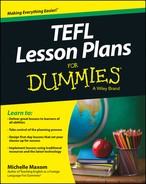Chapter 25
Developing Presentation Skills
In This Chapter
![]() Teaching the kind of language that students’ need to give a good presentation
Teaching the kind of language that students’ need to give a good presentation
![]() Helping students structure effective presentations
Helping students structure effective presentations
![]() Organising two lessons on presentations
Organising two lessons on presentations
Presentations are a part of many university courses and professions these days. For those developing a career that makes use of the English language, getting a foothold on presentation skills in English is vital. This chapter features the structure and lexis students need to speak effectively and professionally in front of others.
Using Presentation Skills as Language Context
When you set your class the task of giving presentations, you provide them with an opportunity to practise various skills. In addition, you have an ideal setting to assess your students’ abilities individually.
Consider these advantages of teaching presentation skills:
- You bring the productive skills of writing and speaking into play in a freer way than in practice activities, and the students are able to show off the language skills they have developed so far.
- The students are likely to research the set topic in English using the Internet and printed resources, which encourages independent learning and authentic use of the language.
- A level of differentiation takes place because all students are able to put their own slant on the set topic.
- Even if they are used to giving presentations in their own language, students are now able to explore what people in the English-speaking world are likely to expect. Students can note cultural differences.
- Students practise the transferrable skill of signposting – using key expressions to move from one stage of a verbal/written presentation to another.
- Giving a successful presentation can really boost a student’s confidence.
- In the preparation and delivery of a presentation session, students play a more active role, which gives them variety and motivation.
- Presentation lessons allow you to embrace a number of approaches and methodologies (referred to in Part 1 of this book) such as task-based learning and CALL (computer assisted language learning).
There are two stages to this plan. The first lesson involves preparation, and the other is the actual delivery on the part of the students.
Use this plan only for students who are of intermediate level and above, because those students will embellish their presentation according to confidence and ability.
Overview for Lesson 1
Here I present the first lesson which prepares students to give a presentation. This lesson gives the students some advice and practice.
Doing a warmer activity
![]() 5 minutes
5 minutes
Play Fortunately/Unfortunately, a game in which you begin a sentence and then nominate a student to complete it by saying ‘Fortunately … ’ or ‘Unfortunately … ’ in order to build up the story. For example:
- T: I saw a famous singer on Oxford Street. Unfortunately …
- St 1: Unfortunately, I didn’t have my camera.
- St 2: Fortunately, my friend had her phone which has a camera in it.
Choosing the topic
![]() 10 minutes
10 minutes
Explain that students will be giving a short presentation each on a specified day and that as a class they must agree on how the presentations will be organised. Set out the criteria, including:
- Audience: Explain whether students will present to the whole class or to a smaller group.
- Time limit: Give a minimum and maximum time; for example, five to eight minutes.
- Topic: Agree the topic of the presentations with the class.
- Visual aids: State whether students should use presentation software, the board, props, and so on.
This is an opportunity for a class discussion, during which you can step back and let the students negotiate in English. You may take a Community Language Learning approach here (refer to Chapter 2 for details about CLL discussions). You could also offer an example or two of presentation topics to get students started. Here are some suggestions:
- A hobby or interest I enjoy
- Important sites and landmarks in my hometown
- Inspirational people
- Ways I can improve my community
- My favourite artist
Setting your students up to succeed
Now that the students have set the criteria for the presentation day, help them to work out the language and structure they need. I put this information into a worksheet to make it easier for the students to discuss and store the language points and tips.
![]() 15 minutes
15 minutes
Prepare a worksheet like that in Figure 25-1 or put the information from the figure on the board/screen. Put students in pairs to discuss the answers. Give examples based on each box in the figure so that the students are clear on how to proceed.

Figure 25-1: Worksheet to prepare students for giving a presentation.
Giving student feedback
![]() 8 minutes
8 minutes
Go over the answers to the worksheet in a feedback session.
The answers to Worksheet in Figure 25-1 are:
- Structure: Introduction/3 main points/conclusion
- Synonyms: Answers depend on the topic. For example, in a presentation entitled ‘Ways we can improve our community’, synonyms for key words could be
- Community: society, neighbourhood, locality, the public
- Improve: advance, develop, correct, boost
- Connecting Words i) in addition, alsoii) or instance iii) thereforeiv) actually v) howevervi) naturally vii) following/after that
- True or False:
- F. The notes should be really reminders and not word for word.
- F. Slow speech is clearer.
- T.
- F.Ask before the presentation.
- F- it’s rude not to pay attention.
- F- you should always organise your ideas so you remember your key points and the audience can follow you more easily.
- T
- T, but only if you actually understand them.
Giving mini presentations
![]() 15 minutes
15 minutes
The students are going to give some mini-presentations to each other as practice. They need some easy topics to present on so that they can concentrate on structure and language instead of content. Try these:
- My family
- My favourite films/books
- My favourite possessions
- My holidays
- My house
- My job/school
Ask a student to pick a topic for you to speak on. Spend a short time making notes on the board in a structured way. Now give a mini-presentation of about three minutes. Another student can time you so that you stop on time.
Now the students take turns to pick a topic, prepare, and speak for three minutes.
Giving feedback
![]() 5 minutes
5 minutes
As a feedback and cooler activity, elicit from students the most interesting facts they learnt about each other during the presentations.
Overview for Lesson 2: Presenting
This lesson is very student-centred because the students deliver their presentations so they don’t need you to teach them. On the actual presentation day make sure that the students have the necessary equipment and that it’s in good working order. Give some consideration to room layout too and ensure that the audience can see the presenters clearly.
Time: Variable depending on the number of students you have
Materials: Sufficient and appropriate equipment for students to deliver their presentations well, for example a computers and internet access, or flipcharts.
Aims: By the end of this lesson the students will have delivered their own presentations, listened to their classmates’ presentations and offered each other feedback.
Doing a warmer activity
![]() 5 minutes
5 minutes
Start with a warmer so that everyone has time to arrive and settle down. Set up ‘proxy interviews’, in which students pretend to be someone else in the room. One student conducts an interview with another student who is now in character as someone else. The interviewer tries to guess who the other student is pretending to be.
Giving the presentations
![]() Most of the lesson
Most of the lesson
As each student gives their presentation, the audience must take notes. This focuses the mind on listening and consequently prompts interesting follow-up questions. Give out a worksheet or ask students to write down headings. Students should note:
- Topic
- Main points
- What they liked best about the presentation
- Any tips/advice for the student who spoke
Depending on your time constraints, students can offer their feedback after each presentation or save it up for the next session.
Extension activities
Students give each other feedback about their presentations. You may make time for one-to-one feedback between you and individual students too.
Discuss with students how the presentations went and together make a checklist of things to remember for the next presentation session.
Before the next presentations, have a lesson on body language. Get students practising these points:
- Ensure good eye contact with the audience.
- Maintain good posture (no slouching, leaning or hands kept in pockets).
- Remove barriers such as folded arms.
- Use hands for meaningful gestures.

 I first found this warmer on the
I first found this warmer on the